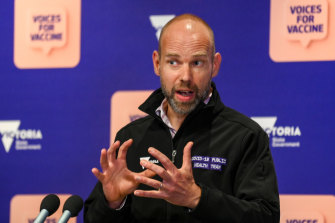Victorian outbreak peak still in sight, but delayed by rule breakers
For our free coronavirus pandemic coverage, learn more here.
It’s predicted Victorians will have to wait another month before the state’s COVID-19 infections start plateauing because of a concerning surge in cases that’s been blamed on grand final parties, coffee dates and other illegal gatherings.
But even as another daily record of 1488 COVID cases were reported, epidemiologists say that the rising vaccination rates should eventually flatten the third wave, before a larger peak expected later this year after the state’s reopening begins.
Jeroen Weimar said some of Victoria’s new cases were linked to illegal gatherings over the grand final weekend.Credit:Eddie Jim
They say the initial flattening could arrive in around four weeks, potentially coinciding with the first significant lifting of restrictions that will see fully vaccinated people in Melbourne allowed to get a haircut and dine and shop outside.
But these predictions make the assumption that there is no more widespread flouting of public health orders. A remaining concern is signs the outbreak is moving into new geographic areas, finding more fertile ground for spread and complicating any predictions about where numbers are heading.
The state’s COVID-19 response commander Jeroen Weimar said on Saturday that around a third of the current cases were being driven by a “significant upswing in social gatherings” across the state, including grand final parties and people meeting up for coffee at their homes.
He warned the jump in numbers had put the state in a difficult space where more than 1000 cases were being reported each day. These numbers will see more COVID-19 hospitalisations (now at 429) in the coming days.
“We really need people to recognise that this is a very perilous path that we’re on, and that we all need to resolve together to hold it down for that much longer,” Mr Weimar said.
“We are four or five weeks away from 80 per cent double dose, it’s not an impossible distance. We have all got to do our bit to hold this down otherwise there will be a huge pressure on our intensive care nursing staff and our ambos and healthcare system.”
One week ago, the majority of cases (84 per cent) were being reported in the northern and western suburbs of Melbourne. On Saturday, following impressive vaccination coverage increases in many of the affected suburbs, that figure had dipped to below 70 per cent and hundreds of new cases were being reported in the south-east, east and regional Victoria.
Deakin University epidemiology chair Catherine Bennett said while the outbreak’s shifting footprint would not necessarily stop Victoria’s case numbers from plateauing, it could make it harder to do “because you are chasing this fire that’s finding new ground”.
“That’s a bit different to NSW where they did manage to keep it quite contained, even though there were a lot of LGAs impacted … and then they could really focus their vaccination efforts.”
Professor Bennett predicted it could take a month before numbers started to plateau, if there was not too much more relaxation of rule-following.
The key measure that will indicate if cases are turning around is the reproduction number – which refers to the number of other people an infected person will go on to infect, on average. For cases to drop, this number needs to fall below zero.
Before last weekend, epidemiologist Adrian Esterman said Victoria was nearing that milestone, reporting a reproduction number of 1.19 on September 17, suggesting the peak could have been expected within a couple of weeks.
“But there’s a very high chance that these people who have been disregarding the restrictions have put that back by two or three weeks,” Professor Esterman said. “It’s a terrible shame.”
On Saturday, he said the reproduction number was 1.5.
Victoria’s numbers are already at the lower end of what the Burnet Institute modelling had predicted for late October, when the state is expected to hit 70 per cent of the population aged 16 and over fully vaccinated, triggering the first stage of the reopening.
Premier Daniel Andrews warned this week that if numbers and hospitalisations continued to grow the planned easing of restrictions might need to be postponed.
As of Friday, 73.5 per cent of the people in Victoria’s hospitals had not received a dose of a COVID-19 vaccine, while 21.5 per cent were partially vaccinated, and 5 per cent were fully vaccinated.
The deaths from COVID-19 of men in their 60s, from Hume and the Mornington Peninsula, were announced on Saturday.
It came as a South Australian resident returning from Victoria tested positive for COVID-19.
South Australia recorded the woman as a local case on Saturday and have alerted eight passengers on Jetstar JQ 778 between Melbourne and Adelaide on Friday as the woman, who was fully vaccinated, returned to the state on that flight.
With Cassandra Morgan
Stay across the most crucial developments related to the pandemic with the Coronavirus Update. Sign up for the weekly newsletter.
Most Viewed in National
From our partners
Source: Read Full Article


